

Centro Mexicano para la Música y las Artes Sonoras. Composers Inside Electronics. Sonic Arts Union. The Sonic Arts Union was a collective of experimental musicians that was active between 1966 and 1976.[1] The founding members of the group were Robert Ashley, David Behrman, Alvin Lucier and Gordon Mumma, all of whom had worked together in the instrumental performances of the ONCE festivals.[2] They initially toured under the name Sonic Arts Group, until, at Ashley's suggestion, the name was changed to Sonic Arts Union.
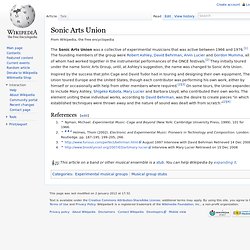
AMM (group) AMM is a British free improvisation group that was founded in London, England in 1965.

The group was initially composed of Keith Rowe on guitar, Lou Gare on saxophone and Eddie Prévost on drums. The three men shared a common interest in exploring music beyond the boundaries of conventional jazz, as part of a larger movement that helped spawn European free jazz and free improvisation. AMM have never been well known to the general public, but have been influential on the field of improvised music.
Sergì Jordà - Music Technology Group - Pompeu Fabra. Digital Luthiere (Jordà, 2005) Música por Computadora. Drum.pdf. Joel Chadabe. Joel Chadabe Joel Chadabe is a composer, pioneer, author and historian, entrepreneur, and educator.
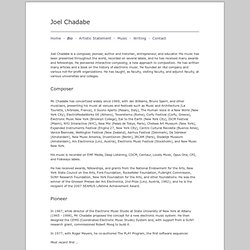
His music has been presented throughout the world, recorded on several labels, and he has received many awards and fellowships. He pioneered interactive composing, a new approach to composition. He has written many articles and a book on the history of electronic music. He founded an r&d company and various not-for-profit organizations. Composer Mr. Music and Life. In lieu of an abstract, here is a brief excerpt of the content: H istory is written backwards from the present to the past.
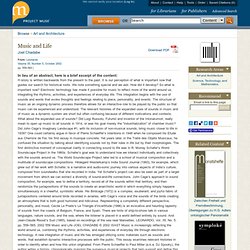
It is our perception of what is important now that guides our search for historical roots. We note something special and we ask: How did it develop? So what is important now? David Tudor. David Eugene Tudor (January 20, 1926 – August 13, 1996) was an American pianist and composer of experimental music.
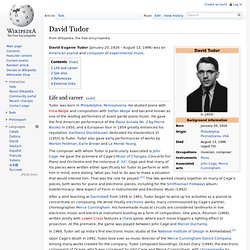
Life and career[edit] The composer with whom Tudor is particularly associated is John Cage. He gave the premiere of Cage's Music of Changes, Concerto For Piano and Orchestra and the notorious 4' 33". Cage said that many of his pieces were written either specifically for Tudor to perform or with him in mind, once stating "what you had to do was to make a situation that would interest him. That was the role he played.”[1] The two worked closely together on many of Cage's pieces, both works for piano and electronic pieces, including for the Smithsonian Folkways album: Indeterminacy: New Aspect of Form in Instrumental and Electronic Music (1992).
After a stint teaching at Darmstadt from 1956 to 1961, Tudor began to wind up his activities as a pianist to concentrate on composing. Tudor died in Tomkins Cove, New York at the age of 70. See also[edit] References[edit] Notes. The Art of David Tudor. A resource drawing on the archival collections of the Research Library at the Getty Research Institute, relating to the work of pianist/composer David Tudor (1926–1996) Created 2001, with minor edits in 2010 Author: Nancy Perloff, Curator of Modern and Contemporary Collections This digital resource is a gateway to the David Tudor papers and related collections of the Research Library at the Getty Research Institute, providing links to online library records and collection finding aids.

It documents and complements the Getty Research Institute symposium "The Art of David Tudor: Indeterminacy and Performance in Postwar Culture," organized in collaboration with the California Institute of the Arts School of Music, which took place in May 2001 at the Getty Center. The resource continues the symposium's mission by addressing Tudor's dual career as a virtuoso pianist and as a composer and performer of live electronic music. Audio & Video (Getty Research Institute)<br> Dialects (1984), live electronics Score by David Tudor (American, 1926–1996), Wire flower sculptures by Jackie Matisse (French, b. 1931)
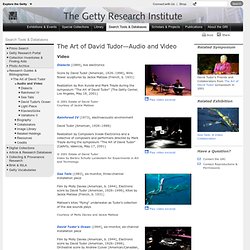
David Tudor recordings collected and released as box set. David Tudor's output from 1963 through to 1992 has been collected and is being released as a seven disc set on New World records.
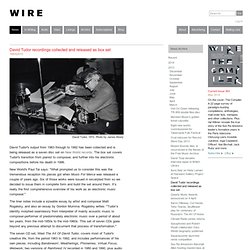
The box set covers Tudor's transition from pianist to composer, and further into his electronic compositions before his death in 1996. New World's Paul Tai says: "What prompted us to consider this was the tremendous reception his pieces got when Music For Merce was released a couple of years ago. Six of those works were issued in excerpted from so we decided to issue them in complete form and build the set around them. It’s really the first comprehensive overview of his work as an electronic music composer. " The liner notes include a sizeable essay by artist and composer Matt Rogalsky, and also an essay by Gordon Mumma. The David Tudor Pages. Dr. Joseph A. Paradiso.
Joseph Paradiso joined the MIT Media Laboratory in 1994, where he is now an Associate Professor of Media Arts and Sciences directing the Responsive Environments Group, which explores which explores how sensor networks augment and mediate human experience, interaction and perception.

His current research interests include embedded sensing systems and sensor networks, wearable and body sensor networks, energy harvesting and power management for embedded sensors, ubiquitous and pervasive computing, localization systems, passive and RFID sensor architectures, human-computer interfaces, and interactive media. He is also serving as co-director of the Things That Think Consortium, a group of Media Lab researchers and industrial partners examining the extreme future of embedded computation and sensing. Paradiso received a B.S. in electrical engineering and physics summa cum laude from Tufts University in 1977, and in 1981 completed a Ph.D. in physics from MIT with Prof.
Ulrich Becker as a K.T. Musical Applications of Electric Sensing. Elements and Introduction to Physical Interaction: Tutorials for Artists and Musicians Introducción y Elementos para Interacción Física: Tutorías para Artistas y Músicos.
Reed Ghazala. Qubais Reed Ghazala, an American author, photographer, composer, musician and experimental instrument builder, is recognized as the "father of circuit bending," having discovered the technique in 1966, pioneered it, named it, and taught it ever since.
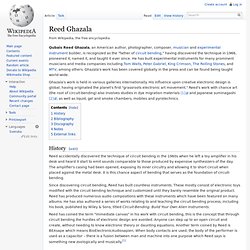
He has built experimental instruments for many prominent musicians and media companies including Tom Waits, Peter Gabriel, King Crimson, The Rolling Stones, and MTV, among others. Ghazala's work has been covered globally in the press and can be found being taught world-wide. Ghazala's work is held in various galleries internationally.
His influence upon creative electronic design is global, having originated the planet's first "grassroots electronic art movement. " Reed Ghazala’s Incantors and his Video Octavox. Reed Ghazala From the book & CD package Gravikords, Whirlies & Pyrophones comes this image of Reed Ghazala‘s Video Octavox. It’s sitting, in this photo, on top of an old-fashioned television set. At the end of each of the eight droopy coiled-wire arms is a light-sensor provided with a suction cup. The sensor can be attached anywhere on the surface of a TV screen. As the TV plays, the varying signals from the 8 sensors serve to modulate eight synthesizer voices, generating a sound track for whatever shows on the screen.
Reed Ghazala is best known as the leading practitioner of circuit bending, the art of deliberately short-circuiting audio components in search of interesting sounds. Reed Ghazala's Anti-Theory Workshop. Circuit Bending With Reed Ghazala. Cuba's DIY Inventions from 30 Years of Isolation.